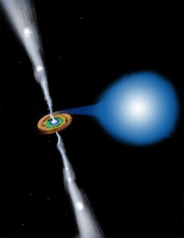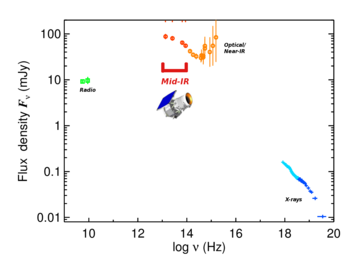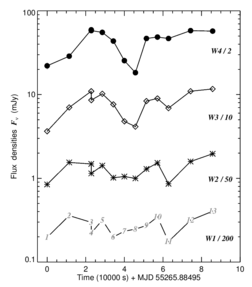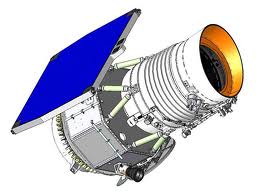Context: Accretion onto black holes results in huge energy liberation. Jets of outflowing matter are a very prominent signature of accretion [see image 1]. Understanding the origin and physical processes driving these jets is a key unsolved problem. But despite decades of study, the composition and physical conditions within these jets, remain largely unconstrained. This is because critical information near the peak of the jet spectrum in the mid-infrared (mid-IR) has not been available to date for most stellar-mass black holes. Many studies at radio, X-ray and visible-light energies have been carried out, but the advantage of the mid-IR is that it probes radiation from the base of the jet just above the black hole.
Breakthrough observations: In the course of the all-sky survey, NASA's WISE telescope has detected a well-known Galactic black hole binary system GX 339-4 during a highly active phase of accretion for the first time in the mid-infrared. Multiple exposures in multiple bands mean that flux and spectral variabilty information is also available in the mid-IR. The WISE data represent a step function advance in our knowledge of Galactic black holes.
The vast majority of all objects in the sky detected in the mid-infrared are expected to be steady and non-variable. These include stars, dust clouds and distant galaxies. The observations of GX 339-4, on the other hand, probe violently-variable non-thermal emission completely unrelated to dust.
Results highlights:
1) The mean observed mid-IR fluxes show clear spectral curvature, and comparison with multi-wavelength quasi-simultaneous data at radio, near-IR, optical and X-ray energies shows that WISE is probing a broad-band break [2].
2) This break matches the signature of a cutoff between self-absorbed and optically-thin radiation in a compact relativistic jet. The exact frequency of this break has been long sought, because it is important for measuring the total energy of particles carried by the jet and the magnetic field (B) which collimates the outflow at the base of the jet.
3) Dramatic variability is found in the mid-IR (in all WISE bands) across 13 epochs of observation. The source brightness changes by factors of 3 or more over just a few WISE orbits[3]. GX 339-4 appears to be one of the most extreme cases of mid-infrared variability in the WISE preliminary all-sky catalog release.
4) The variability is not a simple change in brightness, but rather a change in spectral slope across the bands. In some epochs, the slope is positive (increasing with frequency) whereas at other times, it may be flat, or negative. This implies that the break frequency is shifting across the entire WISE sensitivity range, and often may fall completely outside this range at either end.
5) During the epochs when the break frequency lies within the WISE wavelength range, we measure B of close to 1.5 Tesla, largely independent of the geometry of the jet and plasma energetics. This is about 30,000 times stronger than the Earth's magnetic field. Furthermore, the strong variations imply that the physical conditions of the jet themselves are unstable like an intermittent hose pipe, with changes in the magnetic field or location of the plasma acceleration zone by factors of ~10 occurring.
6) We have compiled one of the most complete broad-band spectra of a black hole binary, in its brightest ever X-ray active ('hard') state [2]. This spectrum will doubtless feed in to, and spawn, many follow-up studies.
Broader implications: WISE has given new insight into the physical conditions at the base of a black hole jet, and shown that these conditions are highly volatile on short timescales. Jets are a characteristic feature of all classes of accreting compact objects, so this work can be used to study scaling relations to the super-massive cousins of stellar black holes: active galactic nuclei. Furthermore, jets are omnipresent in sources with hot magnetized plasmas such as magnetars, gamma ray bursts, and even the Sun. This work is of direct interest to any physicist interested in studying relativistic particle acceleration.



